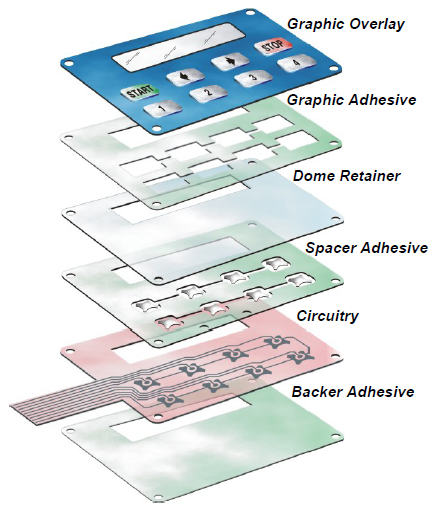Why Membrane Switches Are Essential for Sturdy Control Equipment
Membrane layer switches play an essential role in guaranteeing the toughness and dependability of control systems throughout different sectors. Their special construction allows them to endure difficult environmental variables such as humidity, temperature extremes, and physical wear. This strength not only prolongs the life-span of the systems they offer however likewise reduces maintenance needs. As we explore the diverse benefits of membrane layer switches, it comes to be apparent that their significance goes beyond plain capability, influencing user experience and operational efficiency. What more implications do these features hold for the future of control system design?
Review of Membrane Layer Switches
Membrane buttons are functional and trustworthy elements typically made use of in numerous electronic control systems. These switches include several layers, consisting of a graphic overlay, a spacer layer, and a printed circuit layer. The visuals overlay supplies both practical and aesthetic design, while the spacer layer makes certain that the switches are turned on only when pushed. The published circuit layer has conductive traces that complete an electrical circuit when the membrane is pushed, allowing the device to reply to user inputs.
Membrane buttons are frequently preferred in applications calling for a portable and lightweight layout, making them suitable for portable devices, clinical tools, and industrial equipment. They can be personalized to meet particular individual needs and can incorporate numerous attributes such as backlighting, responsive feedback, and several colors. In addition, membrane buttons are immune to dirt, dampness, and contaminants, making them suitable for settings where resilience is essential.
Advantages of Sturdiness
In several applications, the longevity of membrane switches deals substantial benefits that enhance their overall efficiency and reliability. These switches are developed to withstand harsh environments, making them ideal for usage in requiring conditions such as high moisture, severe temperatures, and direct exposure to chemicals. Their robust building and construction aids to stop damage from physical effect, guaranteeing durable performance and minimizing the requirement for frequent replacements.
Additionally, membrane buttons are immune to deterioration, which is vital in applications where regular communication takes place. This toughness equates to lower maintenance expenses, as companies profit from minimized downtime and less solution interruptions. Additionally, the encapsulated design of membrane layer switches secures inner components from dust and moisture ingress, further adding to their life-span.
Another advantage is their capacity to maintain consistent efficiency over time. With a high resistance for mechanical stress, these switches protect their responsive feedback and electrical stability, guaranteeing user fulfillment. Inevitably, the toughness of membrane layer switches over not only enhances functional performance however additionally promotes self-confidence in their integrity, making them a preferred option for control systems throughout various sectors.
Applications in Various Industries
Durable control systems employing membrane buttons locate comprehensive applications throughout a series of markets, each benefiting from the unique characteristics these switches use. In the medical sector, membrane layer switches are critical for devices such as individual displays and diagnostic equipment, where integrity and convenience of cleaning are extremely important. Their resistance to dampness and impurities ensures they maintain functionality in his response sterile environments.
The vehicle industry leverages membrane layer buttons for control panel controls and infotainment systems, where they offer sleek, low-profile interfaces that boost customer experience. These switches are also created to hold up against extreme conditions, consisting of exposure to severe temperature levels and resonances.
In industrial settings, membrane buttons are generally made use of in machinery control board, providing responsive comments and toughness needed for high-usage applications. Their ability to stand up to chemicals makes them appropriate for producing settings where spills and contaminants are frequent.

Customer electronics, such as kitchen devices and push-button controls, also use membrane buttons for their adaptability and cost-effectiveness. On the whole, the versatility and durable nature of membrane switches make them essential throughout various markets, ensuring reliable operation and longevity in control systems.
Design and Aesthetic Charm
While capability is critical, the layout and aesthetic appeal of control systems equipped with membrane buttons play an important function in user involvement and general experience (membrane switch). The aesthetic design of these switches can substantially influence individual understanding and communication. A well-designed membrane switch improves the beauty of the device, making it more attractive to customers and promoting a link in between the user and the item
Membrane switches provide a lot of versatility in design, permitting producers to customize graphics, colors, and structures to straighten with brand identity and item visual appeals. Making use of lively shades and distinctive patterns can draw attention, while responsive feedback can strengthen the customer's interaction with the device. Furthermore, the capacity to integrate LED signs and backlighting right into the membrane layer button layout this website gives both practical and visual benefits, enhancing visibility and usability in various atmospheres.

Enhancing Individual Experience

Furthermore, membrane layer buttons can be personalized to incorporate graphical interfaces, boosting use by presenting details in a clear and instinctive way (membrane switch). This personalization can include icons, tags, and shade coding that guide customers through facility capabilities with convenience. Furthermore, their convenience enables integration in different settings, guaranteeing consistent efficiency whether in commercial machinery or consumer electronics
The resilience of membrane buttons likewise plays an essential role More Help in individual experience. By withstanding extreme problems and prolonged usage, these buttons lower the likelihood of system failings, therefore promoting integrity and individual confidence. Ultimately, the tactical usage of membrane layer switches not only boosts performance however also significantly improves user interaction with control systems, making them a crucial component in contemporary style.
Final Thought
